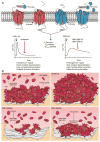PAR4 (Protease-Activated Receptor 4): PARticularly Important 4 Antiplatelet Therapy
- PMID: 29367229
- PMCID: PMC5788293
- DOI: 10.1161/ATVBAHA.117.310550
PAR4 (Protease-Activated Receptor 4): PARticularly Important 4 Antiplatelet Therapy
Figures

Comment on
-
PAR4 (Protease-Activated Receptor 4) Antagonism With BMS-986120 Inhibits Human Ex Vivo Thrombus Formation.Arterioscler Thromb Vasc Biol. 2018 Feb;38(2):448-456. doi: 10.1161/ATVBAHA.117.310104. Epub 2017 Dec 21. Arterioscler Thromb Vasc Biol. 2018. PMID: 29269513 Free PMC article. Clinical Trial.
References
-
- Jacques SL, LeMasurier M, Sheridan PJ, Seeley SK, Kuliopulos A. Substrate-assisted catalysis of the PAR1 thrombin receptor. Enhancement of macromolecular association and cleavage. J Biol Chem. 2000;275:40671–8. - PubMed
Publication types
MeSH terms
Substances
Grants and funding
LinkOut - more resources
Full Text Sources
Other Literature Sources
Medical

